A girl dressed as a ‘catrina’ takes part in the Catrinas Parade in México City to celebrate Day of the Dead. Yuri Cortez/AFP via Getty Images
The melee was unrelated to U.S. participation in World War II, labor unrest or President Franklin D. Roosevelt’s controversial move to seize control of local Chicago industries.
Rather, a massive, impatient art crowd overwhelmed the museum’s capacity, causing mayhem. That’s how desperately people wanted to see the U.S. premiere of an exhibition titled “Posada: Printmaker to the Mexican People.”
The exhibition featured the prints of José Guadalupe Posada, a Mexican engraver who had died in 1913. On display were his calaveras, the satirical skull and skeleton illustrations he made for Day of the Dead, which he printed on cheap, single-sheet newspapers known as broadsides.
One specific calavera, or skull, attracted more attention than the others.
Known as La Catrina, she was a garish skeleton with a wide, toothy grin and an oversized feathered hat. A large print of her hung on the museum’s wall. Audiences saw her featured in the museum’s promotional materials. She was even the cover girl of the exhibition catalog. Back in México she’d been virtually unknown, but the U.S. exhibition made La Catrina an international sensation.
Today, La Catrina is Posada’s most recognizable creation. She’s the icon of Day of the Dead, México’s annual fiesta in honor of the deceased that takes place annually on Nov. 1 and 2. Her visage is endlessly reproduced during the holiday. Her idolization has made her México’s unofficial national totem, perhaps second only to the Virgin of Guadalupe.
While some people might presume it’s always been this way, La Catrina is actually a transcultural icon whose prestige and popularity are equal parts invention and accident.
A life of obscurity
When Posada first engraved her in 1912, she wasn’t even called La Catrina.
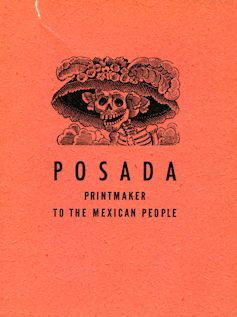
In the original print, she’s Calavera Garbancera, a title used to refer to indigenous peasant women who sold garbanzo beans at the street markets.
Posada illustrated her in ostentatious attire to satirize the way the garbanceras attempted to pass as upper-class by powdering their faces and wearing fashionable French attire. So even from the beginning, La Catrina was transcultural – a rural indigenous woman adopting European customs to survive in México’s urban, mixed-race society.
Like Posada’s other illustrations, the 1912 broadside was sold for a penny to primarily poor and working-class men throughout México City and nearby areas. But there was nothing particularly significant about Calavera Garbancera. Like her creator, she remained obscure for many years.
Posada died broke and unknown, but his illustrations had an afterlife. His publisher reused them for other broadsides well into the 1920s. Calavera Garbancera got recycled as various other characters, none particularly noteworthy. Meanwhile, nobody really knew who made the calavera broadsides they saw around the capital every Day of the Dead.
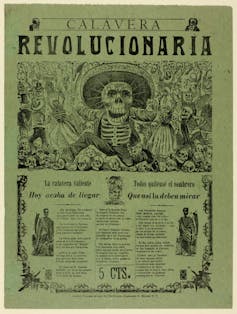
That changed in the mid-1920s when Posada’s work drew the attention of French artist Jean Charlot, a leading figure in the Mexican Renaissance, that creative outburst of nationalist murals and artworks that transpired in the aftermath of the Mexican Revolution.
Charlot was enamored of the calavera illustrations he saw around México City, but he didn’t know who created them. He eventually tracked down Posada’s publisher and began researching the engraver. Charlot published articles about Posada and introduced the artist’s calaveras to other Mexican Renaissance artists and intellectuals. Among the most important were painter Diego Rivera and critic Frances Toor.
From La Garbancera to La Catrina
Rivera, of course, is arguably the greatest artist in Mexican history. His epic murals remain internationally famous.
Frances Toor, on the other hand, was a modest Jewish intellectual who made her career writing about Mexican culture. In 1925 she started publishing Mexican Folkways, a popular bilingual magazine distributed in México and the U.S. With Diego Rivera as her art editor, she started using the magazine to promote Posada. In annual October-November issues, Toor and Rivera featured large reprints of Posada’s calaveras.
However, Calavera Garbancera was never among them. She wasn’t important enough to showcase.
In 1930, Toor and Rivera published the first book of Posada’s engravings, which sold throughout México and the U.S. In it, La Garbancera finally made an appearance. But she had a new name – Calavera Catrina. For reasons unknown, Toor and Rivera chose the honorific, which referred to her as a female dandy. The calavera was forevermore La Catrina.
Her fame, however, didn’t truly arrive until Posada’s riotous debut at the Art Institute of Chicago in 1944. The exhibition was a collaboration between the museum and the Mexican government. It was funded and facilitated by a special White House propaganda agency that used cultural diplomacy to fortify solidarity with Latin America during World War II.
This boosterism allowed the Posada exhibition to tour and give La Catrina wider exposure. She was seen and promoted in New York, Philadelphia, México City and elsewhere in México.
Perhaps more important was the exhibition catalog, which featured La Catrina as cover girl. It sold at each tour location. Complimentary copies were also distributed to prominent U.S. and Mexican authors and artists. They started writing about La Catrina and refashioning her in their artworks, popularizing her on both sides of the border.
La Catrina goes global
In 1947, Diego Rivera further immortalized La Catrina when he made her the focal point of one of his most famous murals, “Dream of a Sunday Afternoon in Alameda Park.”
The mural portrays Mexican history from the Spanish conquest to the Mexican Revolution. La Catrina stands at the literal center of this history, where Rivera painted her holding hands with Posada on one side and a boyhood version of himself on the other [with Frida Kahlo standing directly behind him].
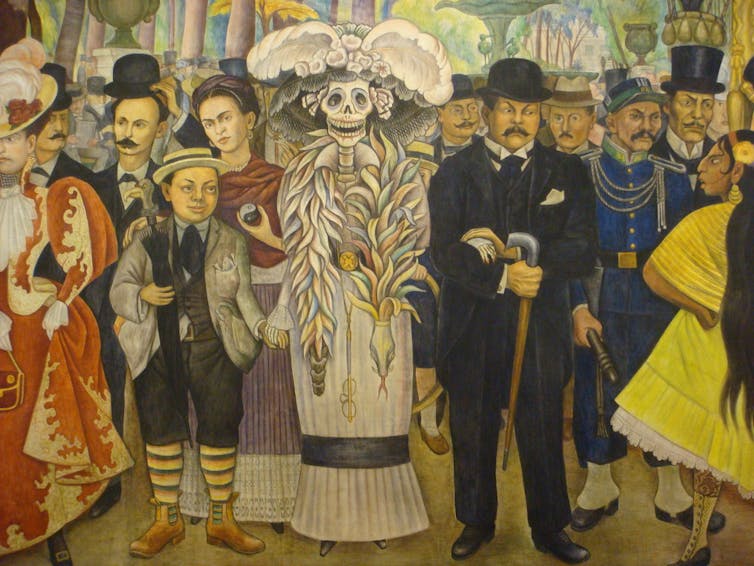
–
Rivera’s fame – and La Catrina’s newfound gravitas – inspired Mexican and Mexican American artists to incorporate her into their works, too.
Folk artists in México began fashioning her into ceramic toys, papier-mâché figurines and other crafts sold during Day of the Dead. Mexican Americans utilized La Catrina in their murals, paintings and political posters as part of the Chicano Movement, which pushed for Mexican American civil rights in the 1960s and 1970s.
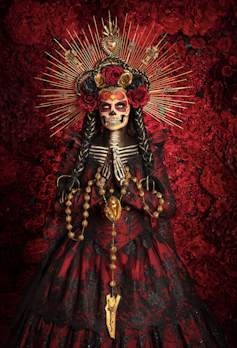
–
La Catrina’s image is now used to sell anything from beer to Barbie dolls. You can order La Catrina costumes from Walmart and Spirit Halloween stores.
In fact, La Catrina costume parades and contests are a relatively new Day of the Dead tradition in México and the U.S. Participants span race, ethnicity and nationality.
Some people, such as “Catrina Christina” in Los Angeles, don a costume each year as a way to honor the dearly departed on Día de los Muertos. Others dress as La Catrina to grow their social media following, or impersonate her to make money.
Posada probably never expected his female calavera to become so famous. He merely wanted to use traditional Day of the Dead humor to make fun of the flamboyantly dressed garbanceras he saw hanging around México City’s central plaza.
Today, during Día de los Muertos, that same central plaza is filled with hundreds of La Catrina impersonators who, for a few dollars, will pose for photographs with tourists all too willing to pay for such a “traditional” cultural experience with an “authentic” Day of the Dead icon.
Posada, meanwhile, is likely laughing somewhere in the land of the dead.
–
- Art
- México
- Visual art
- Costumes
- Chicago
- Artists
- Printmaking
- Day of the Dead
- Murals
- Diego Rivera
- Religion and society
- Skeletons
- Female artists
–
Partners

Arizona State University provides funding as a member of The Conversation US.
Republish our articles for free, online or in print, under a Creative Commons license.
–
Want to write?
Write an article and join a growing community of more than 172,900 academics and researchers from 4,774 institutions.









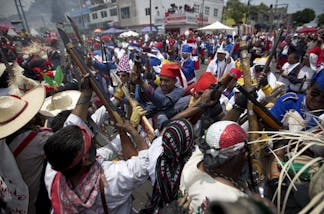
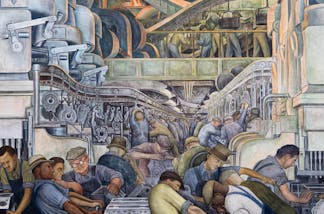

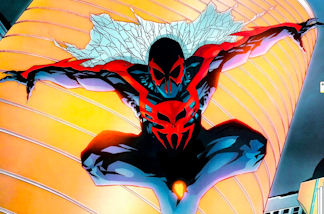
Comments are open on selected articles and must comply with our community standards.
Mike Painter
La Catrina is also a major character in the recent opera “El último sueño de Frida y Diego” (“The Last Dream of Frida and Diego”) by Gabriela Lena Frank, which San Francisco Opera produced in the Spring of 2023